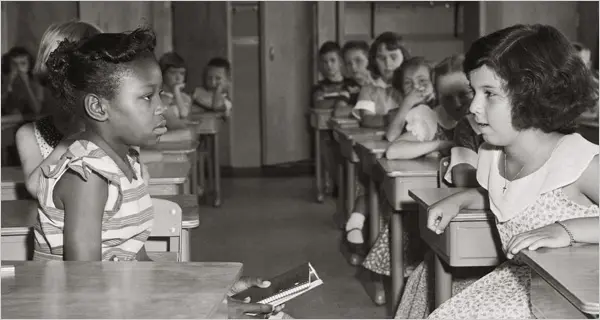The case of Brown v Board of Education arose in 1951 when a public school district in Topeka, Kansas, refused to enroll Oliver Brown’s daughter at the local school closest to their home and required her to take a bus to a segregated school farther away. In similar circumstances, twelve other local black families joined the Brown family in filing a class action lawsuit.
What Was the Case About?
Many of today’s generation don’t know what was Brown v Board of Education about. In 1950, Oliver Brown, a Black father living in Topeka, Kansas, and other local families were forced to drive or ride buses for more than a mile to attend segregated public schools that were not equal to those of their white counterparts. The National Association for the Advancement of Colored People (NAACP) recruited them to file a class-action lawsuit in federal Court against the school board, arguing that this segregation violated their constitutional rights. Thurgood Marshall, then the NAACP Legal Defense Fund’s chief counsel, took the case. In 1954, the Plessy v. Ferguson ruling from 1896 was overturned by the Supreme Court, which declared that separate but equal facilities for racialized students were unconstitutional. This ruling catalyzed the American civil rights movement and opened the way to desegregating public schools, housing, and other public accommodations. The decision was not without controversy, however. Many Americans, especially South Americans, did not welcome this change. They feared that the Supreme Court was overstepping its authority by ruling against segregation, and they were concerned that the justices based their opinion on evidence from social science researchers rather than from precedent and established law. Supporters of judicial restraint also believed that the Justices had violated their duty to interpret the Constitution strictly by its original meaning.
Why Was the Case Important?
Segregation in public schools was ruled unconstitutional by the Supreme Court following its decision in Brown v. Board of Education. The most significant victory in the lengthy history of the NAACP Legal Defense and Educational Fund (LDF) came when it was decided that the Equal Protection Clause of the Fourteenth Amendment rendered laws creating segregated public schools for Black and White students unconstitutional. The case was brought by Oliver Brown, whose daughter Linda was denied entry into Topeka’s all-white elementary school in 1951. When her case and four other segregation-related class action suits from South Carolina, Delaware, Virginia, and Washington, D.C. were heard at the Supreme Court in 1952, the justices grouped them under Brown v. Board of Education. Although the courts that ruled on these cases agreed that the segregation of public schools violated the Fourteenth Amendment, they upheld the “separate but equal” doctrine. The justices in the majority in Brown believed that a public school system in which one race had superior educational resources to the other would create psychological feelings of inferiority among both the children and the adults involved. The slamming of this doctrine opened the door for desegregation in other public facilities such as housing, restaurants, and other places of business. Although this was not accomplished in one fell swoop, it was a significant step forward and paved the way for the late 1950s and ’60s civil rights movement.
How Was the Case Decided?
In a unanimous 9-0 decision in May 1954, the Supreme Court declared state laws permitting segregation of public schools for students of different races to be unconstitutional. The Brown ruling dismantled the legal framework that had been erected to support school segregation and other Jim Crow laws. The National Association for the Advancement of Colored People (NAACP) and its Legal Defense and Educational Fund developed a systematic attack against the “separate but equal” doctrine, starting with cases brought at the graduate and professional levels and culminating in five separate cases that were combined into one case for appeal to the Supreme Court. The lead attorney on the Brown case was Thurgood Marshall, who would go on to become the first black justice of the Supreme Court. During the 1952 hearing, Marshall and his team of attorneys persuasively argued that schools for blacks were demonstrably inferior to those for whites. They were less than half as good as those for whites in most areas of the country. The Justices were divided on the issue, and it took some time to reach a unanimous ruling. A vital element of the Court’s decision was the conviction that segregation was inherently unequal under the Constitution and that the framers of the Fourteenth Amendment meant to forbid it. The justices who voted in favor of desegregation spent considerable effort convincing those initially expected to dissent that a unanimous opinion would be the best way to prevent segregation advocates from using their dissent as a legitimizing counter-argument.
What Impact Has the Case Had on Society?
The decision in Brown discredited the legal rationale for segregation and opened the door to the civil rights movement of the 1950s and 1960s. The 1954 decision, the Civil Rights Act of 1964, and its enforcement by the Justice Department enabled widespread racial integration in schools across America. In a historic ruling, the Supreme Court ruled that racial student segregation in public schools was unconstitutional, overturning its precedent from Plessy v. Ferguson, decided in 1896. The ruling also overturned state laws that permitted the segregation of theaters, hotels, and other public spaces. In 1951, the families of Oliver Brown and a dozen other Topeka, Kansas, families sued the local school district.
They were represented by Charles Hamilton Houston and Thurgood Marshall of the NAACP’s Legal Defense Fund, who had been working on desegregation cases since the 1930s. Marshall was a powerful orator and an effective advocate before the Supreme Court. He and his colleagues presented the case in a way that made it clear that segregation was wrong and unconstitutional. Despite the force of the argument, the Supreme Court was still split on the issue. But in January 1953, Chief Justice Vinson died from a heart attack, and President Eisenhower nominated John Marshall Harlan, the grandson of the lone dissenter in Plessy, to fill the vacancy. Harlan sided with the majority in Brown, and the Court began to move toward ending segregation in schools.



